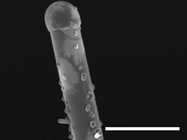Article contents
Processing and functionalization of conductive substoichiometric TiO2 catalyst supports for PEM fuel cell applications
Published online by Cambridge University Press: 17 October 2012
Abstract

The development of substoichiometric TiO2-based nanostructured materials with high aspect ratios for future proton exchange membrane fuel cells is investigated. Nanostructures were manufactured using atomic layer deposition of TiO2 over both anodic aluminum oxide templates and silicon nanowires. It was observed in this work that nanostructures with aspect ratios of 100:1 can be fabricated using both methods. The conductivity of TiO2 films was enhanced following a postdeposition reducing anneal (at 450 °C in H2). Liquid phase-deposited Pt and plasma-enhanced atomic layer deposition of Pt were both found to be appropriate suited for metallization of TiO2 structures.
- Type
- Articles
- Information
- Journal of Materials Research , Volume 28 , Issue 3: Focus Issue: Titanium Dioxide Nanomaterials , 14 February 2013 , pp. 461 - 467
- Copyright
- Copyright © Materials Research Society 2012
References
REFERENCES
- 7
- Cited by


